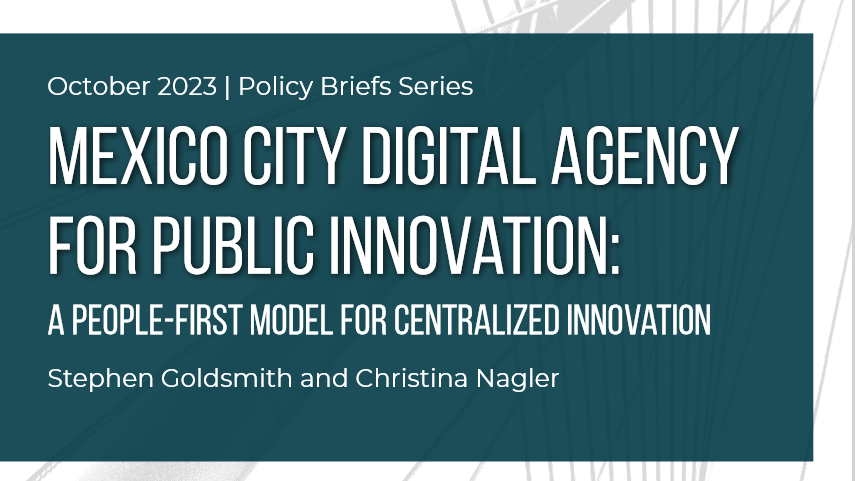- June 17, 2015
- Civic Engagement
This paper is part of a series published by Data-Smart City Solutions, a project of the Ash Center at Harvard Kennedy School. The series explores data-related facets of civic engagement in today’s cities.
Introduction
Working toward inclusive governance takes a multi-stakeholder model. Government cannot – and should not – do it alone. It is not as simple as providing the opportunities for citizens[1] to engage in collaborative decision-making. Rather, citizens have become accustomed to a weak model of engagement – democratic elections every four years that hardly express the accurate will of the people. And these are the democracies.
Digital tools offer the promise of a re-engaged civic sphere. However, they have failed to live up to their potential. The reality, shaped by people, power, and institutions, is much more nuanced. However, there are opportunities for using digital tools to create more inclusive and collaborative structures for governance.
In order to understand the current experiments that work, it is critical to have a more expansive understanding of 21st-century governance. This paper outlines a multi-sector approach to governance, includes promising examples, and offers recommendations for practitioners and researchers alike. Critically, I offer examples that couple civil society with government institutions. This helps ensure citizen engagement is translated directly into improved policy outcomes.
The New Governance
In order to work toward inclusive governance, I propose a multi-pronged strategy that recognizes both the power of traditional government as well as broader definitions of governance that encompass a range of civic actors. This includes thinking beyond efficiency, e.g., service delivery, toward effectiveness – more accountable, transparent, inclusive, participatory, representative, and responsive governance. More inclusive governance can lead to more resilient and adaptive public systems. Building “civic muscles” requires multiple entry points for citizens of diverse backgrounds to participate in a variety of ways.
|
Type[2] |
Features |
|
Individual |
- Individual people not tied directly to an organizational structure - E.g.: First activity happens as a result of a single actor |
|
Non-Government Organization (NGO) |
- Includes civil society organizations, non-profits, and foundations. - Can be domestic, international - E.g.: World Bank, The Participatory Budgeting Project |
|
Community |
- Associations of people, often on the local level, that fall outside the NGO context due to their structure, resources, or capacity - E.g.: Faith organizations and other place-based groups such as farmers markets, one-off hyperlocal groups, informal alliances (i.e., “activists” generally), digital gatherings (listservs, forums), issue advocacy groups |
|
Government |
- International, federal, state, county, other local - E.g.: Libraries, post offices, elected officials |
|
Private Sector |
- For-profit organization with private capital and the goal of generating profits for stakeholders - E.g.: Local business, start-ups, large multinational corporations |
|
Academia |
- Research-based institutions - E.g.: Universities, think tanks, research centers, and other research based organizations |
|
Philanthropy |
- Grant making organizations and foundations, including charitable trusts. - E.g.: private philanthropy, charitable givers, state based foundations (primarily outside of U.S.) |
Inclusive governance must both build the structures for citizens to have meaningful participation in governance as well as strengthen citizens’ ability to participate in such structures. Governments can (and should) empower, legitimate, and structure channels for engagement working together with other sectors. Thus, inclusive governance must address the places in which government can effectively open up spaces for citizens (e.g., participatory budgeting) as well as the opportunities for citizens to self-organize to improve governance outcomes (e.g., community makers’ studios).
Political theorist Mark Warren has an enthusiastic list of civic virtues associated with democracy. They include, but are not limited to, attentiveness to the common good and concerns for justice; tolerance of the views of others; trustworthiness; willingness to participate, deliberate, and listen; respect for the rule of law; and respect for the rights of others.
These qualities matter for building more resilient systems and the civic skills necessary to participate, shape, and form these systems – in particular, processes that build civil society’s capacity to enable stronger communities. In the next section I outline two promising examples of inclusive governance, which directly empower citizens as co-producers in governance.
Each model uses technology in its own unique way. Critically, technology is highly context-specific. Technology, or the greek techne (craft) and logos (words), is not limited to digital tools but can also include a tent, postcards, or a reconverted mail truck.[3] The tools and approaches must put the citizens first. These examples focus on collaborative governance models that can foster deeper engagement among neighbors, communities, and elected officials.
What Works
Technology empowering people to inform public policy
What happens after an election? Typically, when citizens come out to vote, that is the end of their direct involvement in shaping public policy. One critical function of public policy is setting the agenda for a new administration. Yet there is a disconnect between administrations setting new priorities and the opportunities for individuals to effectively express their distinct preferences apart from voting itself. While there are community groups with strong ties to elected officials, many residents are not engaged.
Talking Transition NYC, funded by philanthropies including the Open Society Foundation, was an experiment to engage New Yorkers to inform newly elected Mayor Bill de Blasio’s transition into office. The goal was to create a new digital and in-person interactive experience to foster civic engagement and public dialogue. Nearly 70,000 people shared their views on city services. There was also a robust social media component where people could give de Blasio’s team feedback in real time through Twitter, Facebook, and Instagram.
In addition to digital tools, it featured a physical meeting place, a tent which nearly 15,000 people visited over the course of more than two weeks immediately following election day. The tent housed tablets and online kiosks where people could write down suggested priorities for the next mayor and offer feedback. Social media was displayed throughout the tent – providing a further platform for people to express their preferences.
Talking Transition created one of the most expansive public opinion surveys in New York history. Supplementing online tools were in-person canvassers speaking 19 languages. The finished report outlined eleven key initiatives of pressing concern to New Yorkers. More research is needed to understand how these views are being translated into improved policy outcomes. Yet, the model serves as an illustrative lesson on creative ways to structure civic feedback and frame political transitions.
Technology empowering people to fund public works
Communities throughout the United States have faced budget constraints since the recession. Local governments face an increasing demand to provide services with shrinking budgets. Central Falls, Rhode Island, a dense city of 20,000 people, declared chapter 9 bankruptcy in August 2011. As a result, many of the city’s projects lack resources or staff capacity.
Seeking to address such conditions, the city partnered with a civic crowdfunding platform, Citizinvestor, to offer cutting-edge public funding and engagement models. Much like Kickstarter, the platform enables individuals to pledge dollar amounts. Individual investors are not charged unless the project reaches its full funding goal. Residents identified new trashcans as a neighborhood priority. Lacking in proper trash and recycling bins, the local park was littered with trash from overflowing bins.
68 people donated the money to fund new trashcans. The City partnered with a local nonprofit to design new trash/recycling containers for the park. The new trash bins are a work of art that brought out diverse community members to contribute to their installation. Community members were involved throughout the process – from determining priorities to providing input and dollars.
Central Falls’ use of Citizinvestor creates an important model for others to follow. Perhaps online platforms can harness the power of individual, often small, donations to create public goods; more research is needed to understand precisely at what scale and how to create proper safeguards. However, in times of increased fiscal scarcity, crowdfunding may offer an avenue for civic engagement.
Recommendations
No individual locality, civic association, or government (regardless of scale) can do it alone. However, resources, conveners, and champions can go a long way. Both of these examples involve public-private partnerships. Resources need to include a multi-sector approach leveraging the private sector, universities, and the entire civil/social sector, broadly defined.
Governments should create channels to empower existing communities and their networks. Networks are digital, hyper-local, and at the same time, global. High levels of experimentation are necessary to test and pioneer diverse strategies in cities of different sizes.
States and cities are in fact the “laboratories of democracy.” The locality is re-emerging as a sphere for inclusive governance.[4] One challenge is ensuring these local initiatives can be greater than the sum of their parts. Inclusive governance is not bound to only urban areas. The local level of government, broadly defined to include rural and exurban areas, provides a more manageable size for citizens to be more closely connected to the policies that impact them the most. Connecting local initiatives to the framework of national and international policy could create significant social value.
Civil society can work to support the state and local efforts towards inclusive governance. For example, there are potential criteria for “inclusive governance” in the post-2015 sustainable development goals. A strategy can engage local officials, from municipal leaders to mayors, as well as federal officials working in parallel. Civil society can engage public officials as genuine partners and create mutually agreed-upon timelines and deliverables – with opportunities to revise them.
Many governments fear that engaging citizens will lead to further vulnerability – heightened criticism and an influx of demands with reduced resources. How can inclusive governance enable and build support for choices, rather than the presentation of demands? Civil society can construct coalitions to build up resources, including partnerships with the private sector. Additionally, civil society can work to reduce the perceived political costs of inclusive governance: for example, by publicly acknowledging the limits inherent to government and working to buttress, not just critique them. Creating metrics and indicators of success that reflect process outputs, not only outcomes, can address this. For example, a metric of inclusive governance can include ways in which elected officials genuinely engaged with the public, the availability of accurate information, and the creation of timely accountability channels. Metrics can underscore that sometimes outputs are important outcomes that can lay the foundation for deeper civic participation.
Civil society can help foster the conditions for more successful innovation, experimentation and sustainability – if properly executed.
The United States is only starting to see vague commitments from elected officials about more inclusive governance, concentrated on the local level. There are numerous questions about its authenticity, accountability, and potential obsolescence. Are these elected officials primarily interested in electoral gain? Are these processes uniquely ripe for co-option and corruption? Can civil society ensure legitimacy, continuity between government transitions, and sustained participation? Furthermore, can civil society work in tandem with governance institutions in a bridging capacity?
Government, at all levels, needs to commit to this vision of a more robust role of every day citizens in policy making and leverage digital tools to so do.
Civil society can identify and foster conditions under which inclusive governance is more or less likely to grow. As a result, strategic choices can build up communal resilience. For example, Mount Rainer, Maryland has a strong civic community engaging citizens. Their tool library and bike share program engage a large swath of this, perhaps self-selecting, community.[5] Anchor institutions are one ingredient of success: the Community Forklift home improvement center and Joe’s Movement Emporium performing arts center offer education on production and artist services.[6] Anchor institutions help foster face-to-face engagement and networks of trust that are more important than ever in a highly digital world. Yet, organizations often have fewer resources to mobilize people and keep them involved. One strategy could be finding and strengthening existing anchor institutions across localities, providing support and resources.
Citizens themselves need to take responsibility for their communities. Instead of further disillusionment with politics, digital tools can foster new entry points for civic engagement.
Civil society can play a role as a reliable civic intermediary. Every day, citizens are inundated with too much information. At the same time, most citizens enough lack basic information about their public systems or opportunities to be engaged. Citizens currently lack trust in governing institutions and the heuristics to understand how and where to participate. A trusted intermediary could provide a “civic layer.” This can take many forms. For example, a centralized public sphere, e.g., Boston’s District Hall, a community center, or library. This could also include a centralized online repository, with integrated offline components, of ways citizens can engage – who, what, where, when, and why. Offline components can capitalize on already-vibrant community centers. This can include everything from refurbishing libraries to be 21st-century civic hotbeds, hosting events at makers’ studios, and engaging with small businesses towards more inclusive governance.
Online tools can support and enhance existing opportunities. Building broad and deep inclusive governance that is resilient to elections will require online tools. However, digital tools simply cannot replace the face-to-face interaction that is more important than ever.
At the end of day, building the capacity and opportunity for inclusive governance will require understanding politics and institutions. Technology alone cannot change this reality. Participation is more than the numbers of “clicks,” “total page views,” or “contacts.” It is also about their nature and quality, including genuine opportunities for deliberation and dialogue. Working towards inclusive governance takes more nuanced indicators and metrics.
At times, engaging citizens may take a leap of faith. The evidence comes in narrative form — tracing the origins of ideas and partnerships that grew out of the engagement practice and testimony of leaders about its effects on them.
As political scientist Jane Mansbridge noted in 1995 at the PEGS conference in Washington, D.C.:
Participation does make better citizens. I believe it, but I can't prove it. And neither can anyone else. The kinds of subtle changes in character that come about, slowly, from active, powerful participation in democratic decisions cannot easily be measured with the blunt instruments of social science. Those who have actively participated in democratic governance, however, often feel that the experience has changed them. And those who observe the active participation of others often believe that they see its long run effects on the citizens' character.[7]
Download PDF
[1] Citizen donates political standing to exercise voice/give consent over public decisions, not legal citizenship.
[2] Typology formed in partnership with Laurenellen McCann and Georgia Bullen, see New America writings on civic and social innovation.
[3] For example, see the civic postcard writing campaign in San Francisco and Boston’s City Hall to Go Truck, which delivers city services via a refurbished food truck.
[4] People have always been coming together in their communities; however, these efforts are now receiving a broader, and international, spotlight coupled with the emergence of digital tools.
[7] Jane Mansbridge “Does Participation Make Better Citizens?” paper delivered at the PEGS Conference, February 11-12, 1995.
Top photo credit istock©NYCstocker


 Hollie Russon Gilman holds a Ph.D. from the Department of Government at Harvard University and is a Fellow at Harvard Kennedy School's Ash Center for Democratic Innovation and Governance. She is a Civic Innovation Fellow at New America.
Hollie Russon Gilman holds a Ph.D. from the Department of Government at Harvard University and is a Fellow at Harvard Kennedy School's Ash Center for Democratic Innovation and Governance. She is a Civic Innovation Fellow at New America.


